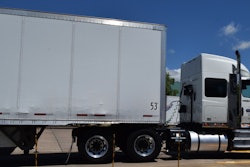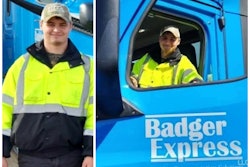When I first got my authority in 1999, like so many I thought that meant I didn’t need to do anything outside of maintaining my insurance, single state permits (now replaced with the Unified Carrier Registration system), truck and trailer registrations, truck and trailer safety inspections, and etc. to be compliant with the Federal Motor Carrier Safety Administration regulations. Like most everyone else, as time went along I began to discover just how shortsighted I was -- there’s a lot more to it.
That brings me to a very important and all too often misunderstood and overlooked requirement of the FMCSA. The MCS-150. Most of us are aware that we are required to do a “Biennial Update” (every other year) of our MCS-150 form. However, that is not the only time we are required to update the MCS-150. The FMCSA requires, as it states on its website:
Any time a motor carrier or other regulated entity changes its Legal Business Name, address, or other details in their record, they should update their US DOT and Operating Authority records with FMCSA in a timely manner.
Most do not realize, including myself in my early years, just how important the accuracy of the MCS-150 can be. Lets talk insurance, first.
Insurance companies use the information the FMCSA receives via the MCS-150 from those who have been awarded a U.S. DOT and/or MC number to assess applicants for insurance, likewise for its existing insureds. All insurance companies look at the basic information (company name, owner’s name, addresses, etc.). However, not all insurance companies look at everything. Have you ever heard the old saying, “They gave me just enough rope to hang myself”? For me, that’s an appropriate way to look at it.

However, it’s not the insurance companies who have given us that rope. It’s the FMCSA!
As reported by Overdrive and many others, the FMCSA does little more than rubber-stamp each application it receives for a U.S. DOT and MC number. It doesn’t check the applicant’s addresses, verify the articles of incorporation or even company ownership. They simply accept what is on the application and -- PRESTO! -- that applicant is now set up to do business, no matter if the company’s legitimate, has a real address or even a real owner. (Is it any surprise that we have a serious run-amok broker fraud problem in trucking? But that is a topic for another day.)
If you are not a bad actor, but simply made an error like a typo, or misunderstood a question ... now it should be easy to see why “they gave me just enough rope to hang myself” is appropriate here.
In my opinion, the best insurance companies are the ones who do the deepest dive into our information. They are doing their best to take that rope away from us and clean up the mess as best they can! Let me explain.
In my story about what goes into calculating your trucking insurance premiums, I briefly discussed why insurance companies don’t like information that doesn’t match. For commercial auto (trucking) insurance, the MCS-150 information we provide to the FMCSA is one of the most important resources insurance companies use to compare to our insurance application.
[Related: What goes into calculate your trucking insurance premium rates?]
Some insurance companies only check what I will call the basics:
- Company name
- Company addresses
- U.S. DOT number
- MC number
- Maybe one or two more general items
Other insurance companies will check those, plus even more:
- Type of operation
- Commodities hauled
- Number of trucks
- Type of trucks
- Distance trucks travel
- Number of drivers
- Carrier miles
And more.
Those same insurance companies, those who go the extra mile, will also compare all that they have learned from our application for insurance and the MCS-150 information with other resources to verify the existence of our company (that it’s a legitimate company), vehicle registrations and history.
Insurance companies that take the time to look at the most information are the insurance companies who want to only insure the best trucking companies (that is to say, the lowest risks to insure). As a result, since they only offer insurance to the best trucking companies, they offer the lowest premiums.
[Related: Yes, you can reduce your trucking insurance premium ... and I have the customers to prove it]
When one of those insurance companies who has done that deep dive offers coverage to one of my insureds, it can come with a requirement: To correct to the MCS-150 (update the commodities, number of trucks, radius of operation, etc.). When that happens, it means the insurance company is satisfied that the trucking company is a risk (low) they would be willing to insure. That is a good thing! Other times those better insurance companies will simply decline to quote. That means fewer insurance companies I can get quotes from for my insured, reducing the likelihood that the insured will get the lowest possible premium.
Had that MCS-150 been current and accurate, though, they may well have.
There is one specific part of the MCS-150 that is frequently overlooked or incorrectly completed or updated. Most of the time I believe it is not intentional, but a simple error. I have personal experience with this for my own authority. After pulling a reefer for more than 20 years, in 2015 I decided to haul flatbed freight again -- and cars on my flatbed when needed. On the MCS-150 it was easy enough to update my commodities. However, it also required me to update question #25, pertaining to hazmat commodities. Most do not realize that there are commodities that can be hazmat. Cars are one of those commodities. They are a Class 9 hazmat commodity.
Disclaimer: I no longer transport any hazmat. I am not a hazmat expert or an attorney. This is not expert or legal advice for transporting hazmat. Consult a hazmat expert or attorney to receive legal advice or guidance pertaining to any of the following:
- Hazmat classes 1-8 usually require $5,000,000 in Bodily Injury and Property Damage (BIPD) liability insurance coverage (it can vary depending on the specific hazmat commodity), placards and a hazmat endorsement on the driver’s CDL.
For Class 9 hazmat, though BIPD liability insurance requirements are significantly lower than classes 1-8. Class 9 typically requires $1,000,000. To transport class 9 hazmat, an endorsement on the driver’s CDL is not usually required, and in most cases placards are not required on the container (trailer). Some of the other Class 9 hazmat commodities can include but are not limited to:
- Dry Ice
- Asbestos
- Lithium batteries
- Battery-powered vehicle
- Benzaldehyde
- Automobile airbags
Always read the bill of lading (BOL). Check to see if any of the commodities on the BOL are listed in the U.S. DOT's Emergency Response Guidebook and follow its guidance. Discuss any concerns you may have with the shipper.
As I have mentioned many times over in several other articles, deception, whether intentional or unintentional, can result in very serious consequences. Imagine getting involved in an accident after failing to accurately and timely report transporting class 9 hazmat on your MCS-150. It doesn’t take much of an imagination to see how this could result in an unbelievable amount of financial and punitive consequences from local authorities, the FMCSA and/or insurance stalkers (aka lawyers). Not to mention the very real potential of the insurance company denying claims for physical damage, cargo, and etc., that they are not otherwise obligated to settle (MCS-90 endorsement for BIPD liability to others).
[Related: Don't get lured into dishonesty to reduce your trucking insurance premiums]
In conclusion, I’m going to step up on my soap box. As many of you know, I started driving a truck in 1983. I applied for and got my own U.S. DOT and MC numbers in 1999, which I still have to this day. Just like most others of my generation, I have seen a serious decline in the quality and safety of the trucking industry. To say it’s alarming would be a gross understatement. There are two glaring issues that need to be addressed and corrected.
First, at a minimum, for any application for a U.S. DOT number the FMCSA receives, the FMCSA should be required to verify the articles of incorporation or sole proprietorship of the company and physically verify that both the company’s physical and mailing addresses are legitimate addresses occupied and used by the company. The FMCSA should also be required to perform a physical biennial re-verification to confirm the that the company is still operating compliantly.
Second, way too many are able to obtain a U.S. DOT and MC number and enter into this industry without a clue as to what is required of them. Insurance agents, financial planners, real-estate brokers, etc. are all required to receive a certain basic level of education, take and pass an exam, purchase a license, perform continuing education to keep up with regulatory changes (or the license can’t be renewed). License renewals for those kinds of entities are required every year or two.
If this same standard was applied to those seeking a U.S. DOT and MC number, there would be a dramatic decrease in those who fail to maintain compliance with safety regulations and everything else -- IFTA, IRP, UCR, the tax regs of the IRS, labor rules under the DOL.
On more than one occasion, I have seen or witnessed the damage caused by an 80,000-lb. truck and trailer involved in an accident. Physical and financial damage to others is too often the result -- much more damage, furthermore, than any insurance agent, financial planner, real-estate broker, etc., could possibly do.
Isn’t it about time to require some basic safety and compliance training, testing and licensing prior to obtaining a U.S. DOT and/or MC number?
I personally think it’s long overdue.
[Related: FMCSA mulls ‘proficiency exams’ for authority]
Need help with your own insurance? Call the author of this story, W. Joel Baker -- if you have questions about insurance you'd like to see addressed by Baker here in Overdrive, drop a comment under this story or get in touch with him directly via his websites.
 Find more information on the ins and out of trucking insurance in-depth in Chapter 16 of the Overdrive/ATBS-coproduced "Partners in Business" book for new and established owner-operators, a comprehensive guide to running a small trucking business. Click here to download the most recent edition of Partners in Business free of charge.
Find more information on the ins and out of trucking insurance in-depth in Chapter 16 of the Overdrive/ATBS-coproduced "Partners in Business" book for new and established owner-operators, a comprehensive guide to running a small trucking business. Click here to download the most recent edition of Partners in Business free of charge.











